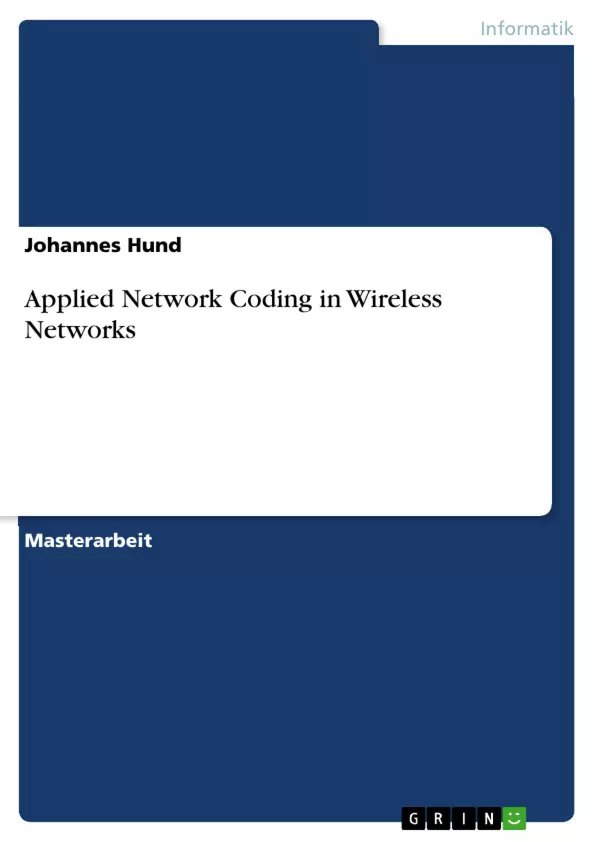Network coding describes a technique to perform coding operations on packet contents throughout the network, increasing the information density of a single transmission and therefore increasing network throughput.
This book describes the portation of an application of network coding onto an embedded linux. It therefore describes the software COPE, which is a network coding implementation based on the modular software router CLICK. This router is also introduced.
Then the book explains the embedded Linux system OpenWRT and the portation of a software onto that system as well as the compilation and deployment of a new firmware image.
Then the experiment and its results are explained.
The work then introduces novel schemes of network coding based on the idea behind COPE. These schemes are based on the improvement of resience rather than throughput.
Inhaltsverzeichnis
- 1. Introduction
- 1.1. Network Coding
- 1.1.1. Principle
- 1.1.2. Linear Coding
- 1.1.3. Deterministic Coding
- 1.1.4. Decentralized network coding
- 1.1.5. Random Coding
- 1.2. Peer-to-Peer Swarming
- 1.2.1. Microsoft Avalanche
- 1.2.2. Codetorrent
- 1.3. Haggle
- 1.4. COPE
- 1.4.1. Opportunistic Listening
- 1.4.2. Opportunistic Coding
- 1.4.3. Opportunistic Routing
- 1.4.4. Pseudo Broadcast
- 1.4.5. Realization of the Cope principle
- 1.4.6. Performance Bottlenecks for TCP
- 1.1. Network Coding
- 2. Implementations
- 2.1. MIT Reference Implementation
- 2.1.1. CLICK
- 2.1.2. Roofnet
- 2.1.3. Madwifi-stripped
- 2.1.4. COPE elements
- 2.2. OpenWRT
- 2.2.1. Stable Branch / White Russian
- 2.2.2. "Bleeding Edge" / Kamikaze
- 2.2.3. Buildroot Environment
- 2.2.4. Packages
- 2.2.5. Image Deploying / Flashing
- 2.1. MIT Reference Implementation
- 3. Measurements
- 3.1. Layout of the experiments
- 3.1.1. Retransmissions
- 3.1.2. Bandwidth
- 3.1.3. Memory leak
- 3.2. Measurement results
- 3.2.1. Throughput without coding
- 3.2.2. Throughput with coding
- 3.2.3. Analysis
- 3.3. Conclusion of the experiments
- 3.1. Layout of the experiments
- 4. Resilience through redundancy
- 4.1. Zaib Quality of Service
- 4.1.1. Problems Addressed
- 4.1.2. Improvements
- 4.1.3. Complete solution
- 4.1.4. Example
- 4.1.5. Simulation / Analysis
- 4.2. Adaptive Preventive Redundancy
- 4.2.1. Problems addressed
- 4.2.2. Improvements
- 4.2.3. Complete solution
- 4.2.4. Example
- 4.2.5. Advantages against Reed-Solomon Coding
- 4.3. Outlook
- 4.1. Zaib Quality of Service
Zielsetzung und Themenschwerpunkte
Diese Masterarbeit untersucht die Anwendung von Netzwerk-Codierung in drahtlosen Netzwerken. Sie analysiert die Prinzipien der Netzwerk-Codierung, verschiedene Implementierungen und deren Auswirkungen auf die Leistung von drahtlosen Netzwerken. Die Arbeit befasst sich insbesondere mit der COPE-Architektur (Cooperative Opportunistic Packet Encoding), die eine effiziente und robuste Datenübertragung in dynamischen drahtlosen Umgebungen ermöglicht.
- Grundlagen der Netzwerk-Codierung und ihre Anwendung in drahtlosen Netzwerken
- Die COPE-Architektur und ihre zentralen Elemente wie opportunistisches Hören, Codierung und Routing
- Implementierungen der Netzwerk-Codierung, insbesondere im OpenWRT-Umfeld
- Messungen der Leistung von Netzwerk-Codierung in realen Szenarien
- Resilienz und Fehlertoleranz in drahtlosen Netzwerken durch redundante Datenübertragung
Zusammenfassung der Kapitel
Kapitel 1 führt in die Thematik der Netzwerk-Codierung und ihre Anwendung in drahtlosen Netzwerken ein. Es werden verschiedene Konzepte und Ansätze wie Peer-to-Peer Swarming, Haggle und COPE vorgestellt.
Kapitel 2 befasst sich mit verschiedenen Implementierungen der Netzwerk-Codierung, insbesondere mit der MIT Reference Implementation und OpenWRT. Es werden die verschiedenen Komponenten und Konfigurationen der Implementierungen erläutert.
Kapitel 3 präsentiert die Ergebnisse von Messungen, die die Leistung der Netzwerk-Codierung in verschiedenen Szenarien evaluieren. Die Ergebnisse zeigen die Auswirkungen der Codierung auf den Datendurchsatz und die Zuverlässigkeit der Übertragung.
Kapitel 4 untersucht verschiedene Ansätze zur Verbesserung der Resilienz und Fehlertoleranz in drahtlosen Netzwerken durch redundante Datenübertragung. Es werden die Konzepte Zaib QoS und Adaptive Preventive Redundancy vorgestellt.
Schlüsselwörter
Netzwerk-Codierung, COPE, OpenWRT, drahtlose Netzwerke, Peer-to-Peer Swarming, Resilienz, Redundanz, Datendurchsatz, Fehlertoleranz, Quality of Service.
- Citar trabajo
- Dipl.-Inf. (FH), M. Sc. Johannes Hund (Autor), 2007, Applied Network Coding in Wireless Networks, Múnich, GRIN Verlag, https://www.grin.com/document/148477



